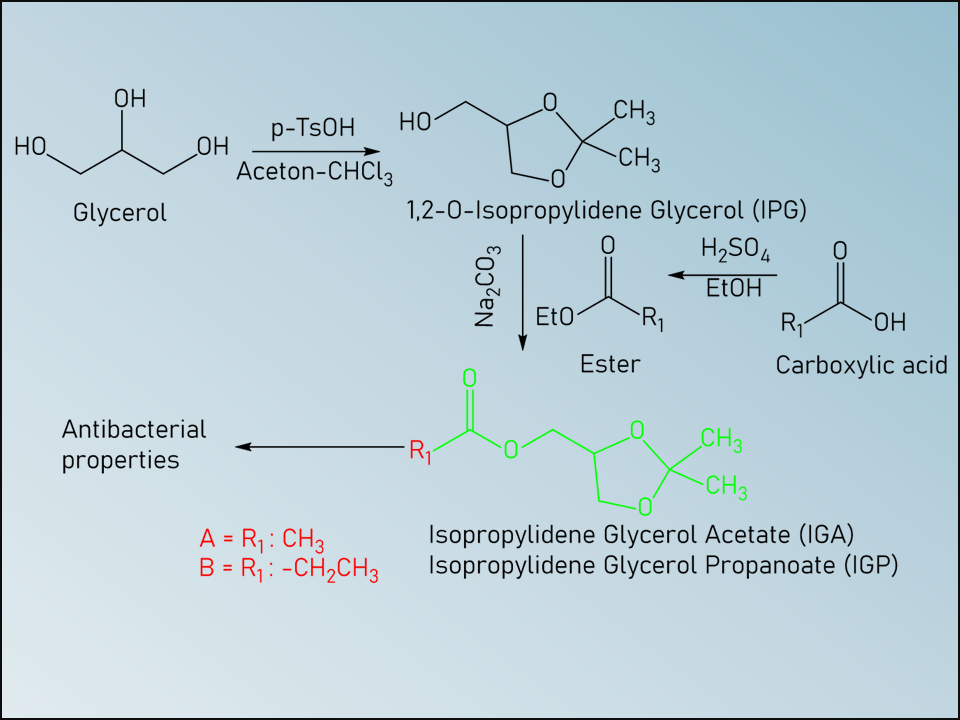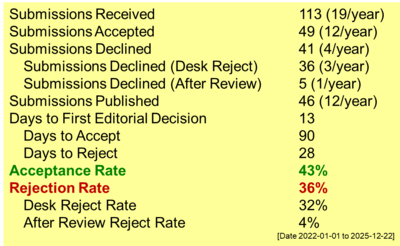Synthesis and Characterization of Isopropylidene Glycerol Acetate and Isopropylidene Glycerol Propanoate Compounds
DOI:
https://doi.org/10.55749/ijcs.v2i2.30Keywords:
Isopropyliden glycerol, Isopropylidene glycerol acetate, Isopropylidene glycerol propanoate, Short chain carboxylicAbstract
Isopropylidene Glycerol Acetate (IGA) and Isopropylidene Glycerol Propanoate (IGP) as ester compounds using acetic and propanoic acids have been synthesized, characterized, and studied for their antibacterial properties. The IGA was synthesized from ethyl acetate (EtOAc) and 1,2-O-isopropyliden glycerol (IPG) with a mole ratio of 1:8 through a transesterification reaction. Meanwhile, the IGP was synthesized using ethyl propanoate (EP) with the same ratio and method as IGA. All materials in this study were identified using FT-IR, GC-MS, 1H-NMR, and 13C-NMR. The characterization results indicated that the compounds of EP, IPG, IGA, and IGP had been successfully formed and identified. It was also revealed that the compounds of EP, IPG, IGA, and IGP were successfully synthesized with yields of 37.72, 27.78, 70.11, and 63.83%, respectively. The antibacterial activity test revealed that neither IGA nor IGP inhibited the growth of Staphylococcus aureus or Escherichia coli at concentrations of 62.5; 125; 250; 500; and 1000 ppm. Therefore, it was asserted that ester compounds synthesized with short-chain carboxylic acids, such as propanoic and acetic acids, lacked antibacterial properties.
References
Pegu, K., More, P., & Arya, S.S. 2023. Application of different orifices for hydrodynamic cavitational effects on deactivation of Escherichia coli and Staphylococcus aureus in milk. Food Bioprod. Process. 141. 49–59. doi: https://doi.org/10.1016/j.fbp.2023.07.003.
Afzali, S., Doosti, A., Heidari, M., Babaei, N., Keshavarz, P., Nadem, Z., & Kahnamoei, A. 2021. Effects of Staphylococcus aureus enterotoxin type A on inducing the apoptosis in cervical cancer cell line. Gene Reports. 25. 101397. doi: https://doi.org/10.1016/j.genrep.2021.101397.
He, Q., Liu, D., Ashokkumar, M., Ye, X., Jin, T.Z., & Guo, M. 2021. Antibacterial mechanism of ultrasound against Escherichia coli: Alterations in membrane microstructures and properties. Ultrason. Sonochem. 73. 105509. doi: https://doi.org/10.1016/j.ultsonch.2021.105509.
Nirmal, N.P., Chunhavacharatorn, P., Chandra Khanashyam, A., Li, L., & Al-Asmari, F. 2023. Cinnamon bark oil in water nanoemulsion formulation, characterization, and antimicrobial activities. LWT. 179(4). 114671. doi: https://doi.org/10.1016/j.lwt.2023.114671.
Yang, D., Jiang, Z., Meng, Q., Wang, S., Pan, H., Rao, L., & Liao, X. 2023. Analyzing the pressure resistant, sublethal injury and resuscitable viable but non-culturable state population of Escherichia coli, Staphylococcus aureus, Bacillus amyloliquefaciens and Lactiplantibacillus plantarum under high pressure processing. Food Res. Int. 173(P1). 113336. doi: https://doi.org/10.1016/j.foodres.2023.113336.
Yuann, J.M.P., Lee, S.Y., He, S., Wong, T.W., Yang, M.J., Cheng, C.W., Huang, S.T., & Liang, J.Y. 2022. Effects of free radicals from doxycycline hyclate and minocycline hydrochloride under blue light irradiation on the deactivation of Staphylococcus aureus, including a methicillin-resistant strain. J. Photochem. Photobiol. B. Biol. 226. 112370. doi: https://doi.org/10.1016/j.jphotobiol.2021.112370.
Guan, G., Zhang, L., Zhu, J., Wu, H., Li, W., & Sun, Q. 2021. Antibacterial properties and mechanism of biopolymer-based films functionalized by CuO/ZnO nanoparticles against Escherichia coli and Staphylococcus aureus. J. Hazard. Mater. 402. 123542. doi: https://doi.org/10.1016/j.jhazmat.2020.123542.
Roy, A.S., Cheruvathoor Poulose, A., Bakandritsos, A., Varma, R.S., & Otyepka, M. 2021. 2D graphene derivatives as heterogeneous catalysts to produce biofuels via esterification and trans-esterification reactions. Appl. Mater. Today. 23. 101053. doi: https://doi.org/10.1016/j.apmt.2021.101053.
Kim, J., Yu, H., Yang, E., Choi, Y., & Chang, P.S. 2023. Effects of alkyl chain length on the interfacial, antibacterial, and antioxidative properties of erythorbyl fatty acid esters. LWT. 174. 114421. doi: https://doi.org/10.1016/j.lwt.2022.114421.
Moussaoui, O. et al. 2021. Selective synthesis of novel quinolones-amino esters as potential antibacterial and antifungal agents: Experimental, mechanistic study, docking and molecular dynamic simulations. J. Mol. Struct. 1241. 130651. doi: https://doi.org/10.1016/j.molstruc.2021.130652.
Patel, N.K. & Shah, S.N. 2015. Biodiesel from Plant Oils. Elsevier Inc. doi: https://doi.org/10.1016/B978-0-12-800211-7.00011-9.
Park, S.H. & Kim, H.K. 2020. Antibacterial activity of emulsions containing unsaturated fatty acid ergosterol esters synthesized by lipase-mediated transesterification. Enzyme Microb. Technol. 139. 109581. doi: https://doi.org/10.1016/j.enzmictec.2020.109581.
Natalia, A., Kim, S. jin, & Kim, H.K. 2016. Antioxidant and antibacterial activity of fatty acid vanillyl ester produced by Proteus vulgaris K80 lipase-mediated transesterification. J. Mol. Catal. B Enzym. 133. S475–S481. doi: https://doi.org/10.1016/j.molcatb.2017.03.012.
Yu, C.C., Lee, Y.S., Cheon, B.S., & Lee, S.H. 2003. Synthesis of Glycerol Monostearate with High Purity. Bull. Korean Chem. Soc. 24(8). 1229–1231. doi: https://doi.org/10.5012/bkcs.2003.24.8.1229.
[15] Gao, S., Liang, X., Wang, W., Cheng, W., & Yang, J. 2007. High efficient acetalization of carbonyl compounds with diols catalyzed by novel carbon-based solid strong acid catalyst. Chinese Sci. Bull. 52(21). 2892–2895. doi: https://doi.org/10.1007/s11434-007-0363-1.

Downloads
Published
How to Cite
Issue
Section
License
Copyright (c) 2023 Indonesian Journal of Chemical Studies

This work is licensed under a Creative Commons Attribution-ShareAlike 4.0 International License.






















